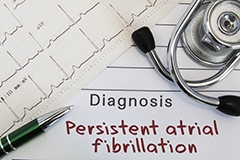What is Cardiac Ablation: Fixing a Heart’s Short Circuit
Medically Reviewed by Prabal K. Guha, MD
Flutter. Fibrillation. Tachycardia.
All three terms describe a problem, when the heart muscles aren’t receiving the proper electrical signals. The result? Erratic heart beats.
Some of the most common occur in the upper chamber of the heart – the atrium. In Atrial Fibrillation or Atrial Flutter, wayward electrical signals send the heart beating about 300 times a minute – four times the normal rate.
Some abnormal heart rhythms can be treated with medication or a change in lifestyle. Unfortunately, these treatments are not always successful.
“Luckily, there is a treatment called cardiac ablation that can be used for arrhythmias in the upper chamber of the heart,” says McLeod Electrophysiologist Dr. Prabal Guha. “It’s successful in more than 90% of patients. To fix this electrical short circuit, we need to go into the heart and eliminate the faulty or extra pulses.”
First, the patient has Electrophysiology study by placing small wires through a blood vessel into the heart to map the electrical paths and pulses.
When the problem pulses or locations are identified, tissue causing the short circuit is destroyed – returning the heart’s rhythm to normal.
The Electrophysiologist uses one of several methods to “ablate” the tissue:
- Radiofrequency ablation. An electrical signal is sent through the catheter into the heart, creating heat, similar to a microwave. The heat destroys the abnormal tissue, leaving small lesions.
- Cryoablation. Rather than heat, this technique uses cold directed through a probe into the heart, freezing the abnormal tissue.
On some patients, the ablation is performed while the patient is having the EP study. Other times, a patient is scheduled for the ablation at a later appointment.
During the procedure – which normally lasts 2 to 4 hours – a patient may feel some minor discomfort and light-headedness. As the procedure progresses, the patient may feel their heart beat change.
After the procedure, the patient lies flat in a recovery area for several hours and is usually sent home the same day. They’ll feel fatigue and an achy chest for a few days. They may also notice the heart adjusting to its new pattern.
Sources include: McLeod Health, National Institutes of Health, American Heart Association, Canadian Heart Rhythm Society, Heart Rhythm Society (US).
-
McLEOD REGIONAL MEDICAL CENTER FLORENCE
843-777-2000 -
McLEOD DARLINGTON
843-777-1100 -
McLEOD DILLON
843-774-4111 -
McLEOD LORIS
843-716-7000 -
McLEOD SEACOAST
843-390-8100 -
McLEOD CHERAW
843-537-7881 -
McLEOD CLARENDON
803-433-3000



-
McLEOD REGIONAL MEDICAL CENTER FLORENCE
843-777-2000 -
McLEOD DARLINGTON
843-777-1100 -
McLEOD DILLON
843-774-4111 -
McLEOD LORIS
843-716-7000 -
McLEOD SEACOAST
843-390-8100 -
McLEOD CHERAW
843-537-7881 -
McLEOD CLARENDON
803-433-3000
 Find a Doctor
Find a Doctor  Locations
Locations  Services
Services 